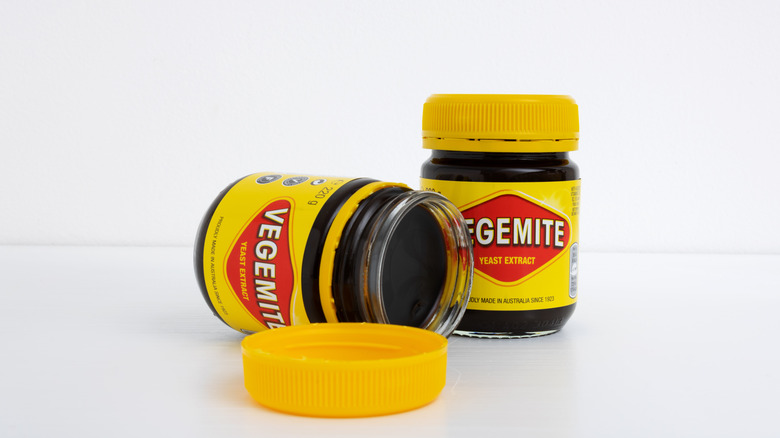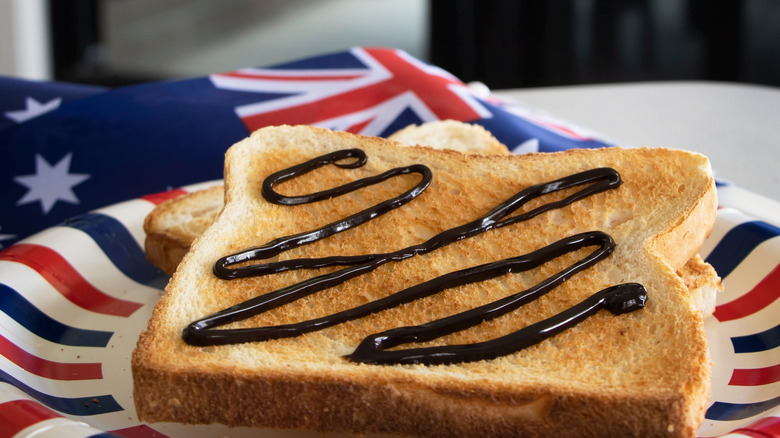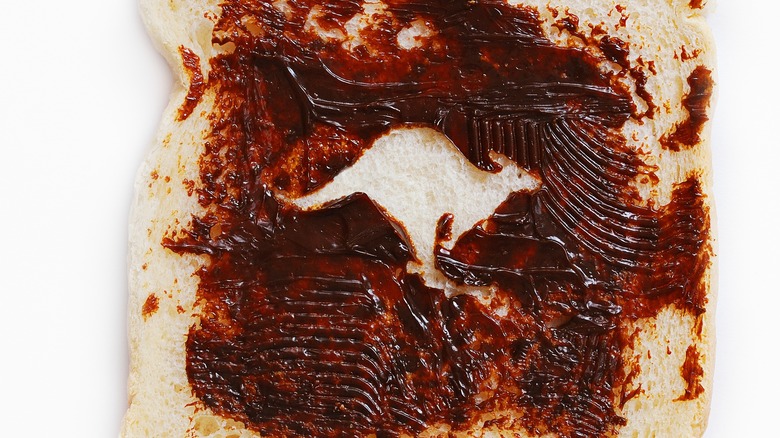Vegemite Can Conduct Electricity (Not That You'll Ever Need It To)
If you've never studied abroad in Australia or visited "the land down under," you may be thinking, "Vege-what?" And if you are familiar with this Australian specialty, then you likely know that Vegemite is something many Americans love to hate, including former president Barack Obama (per VICE). However, the spread is often considered an Australian staple.
Actor Liam Hemsworth said he grew up eating Vegemite on toast, which may have inspired his ex-wife Miley Cyrus to get a Vegemite tattoo while the couple was still an item. But this acquired taste has been around since long before Hemsworth's time, first appearing in Australian stores in 1923. Invented by food scientist Cyril Percy Callister, Vegemite is a rich and dark salty spread made from the remains of brewer's yeast, which is often used to make bread and beer. The spread is used on toast, bread, crackers, or sandwiches.
In honor of Vegemite's hundredth birthday, the brand wrote to the late Queen Elizabeth II, asking if she'd send a birthday card to honor the occasion (per skynews.COM.AU). The brand even plastered the reminder on billboards around Australia that read "G'DAY YOUR MAJESTY. AS WE CELEBRATE YOUR BIRTHDAY DOWN UNDER, JUST A HEADS UP THAT NEXT YEAR WE'RE TURNING 100. CAN'T WAIT FOR YOUR LETTER!"
The brand is not just known for its humor, but it's also a topic of discussion in the scientific community. Some sources suggest that it may be used to save lives someday (via MENTAL FLOSS).
How Vegemite can be used to conduct electricity
While Vegemite is typically known as either the butt of the joke or a beloved treat, some scientists have other ideas about how the paste could be useful. In 2015, Australian scientist Marc in het Panhuis, who teaches at Australia's University of Wollongong, found that Vegemite can also be used to conduct electricity (per MENTAL FLOSS).
In a video, the chemist demonstrates this process. He says, "So what we start with is your normal household Vegemite that I just got from my own kitchen, and what we do in order to make it a little bit better, processable, we'll put it in a household syringe." He then shows how to ignite an LED circuit using Vegemite. He says, "So I come in, complete the circuit between the LED and the battery [using Vegemite] and it lights up." The scientist explains that Vegemite has properties like ions and water, which is what allows the paste to help conduct electricity. He adds that Vegemite can still even start an LED when it is placed on bread.
In the video, in het Panhuis also explores whether or not you can 3D print Vegemite. He suggests that Vegemite is a good candidate for 3D printing because you can use Vegemite as a spread, which allows scientists to put it in a "syringe." The researcher shows how he inserts Vegemite into this part of the 3D printer at his university.
Could Vegemite save your life?
Although the scientist uses the Australian paste to 3D print his university's logo and says you can even eat the paste on toast after it's used to generate electricity or in a 3D printer, he is hoping to use the spread for more than a snack or showcasing a logo.
Instead, in het Panhuis and other researchers are hoping Vegemite can be used in the medical community (per IEEE Spectrum). He is working on creating "edible and 3D-printable hydrogels, which can be used to make things like medical sensors that gather data from within the human body, then disappear naturally when their job is done." In other words, the sensors could collect information from your body after you digest them, indicating that they may be able to assist with the early prevention of various conditions.
Previously, the scientist has used other foods to create the hydrogels, such as Jell-O. However, the researchers are trying to navigate how they can get the information that comes from the devices before they evaporate. While in het Panhuis says the project is still "a little way off," he adds that in the future, he hopes to create something that can be small enough to be swallowed.
While its potential role in medicine is still unknown, it looks like Vegemite could become more than just an Australian "favourite."


